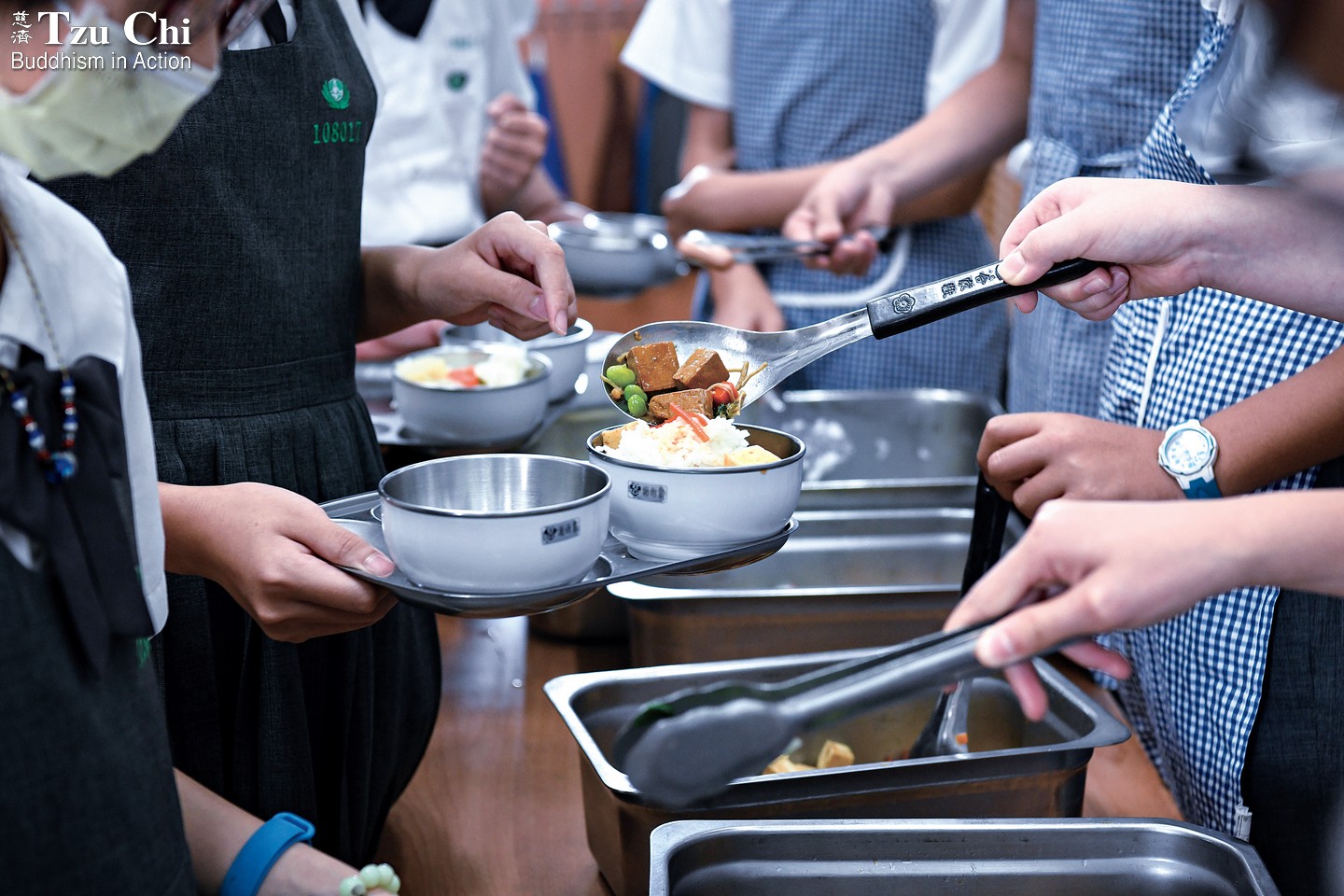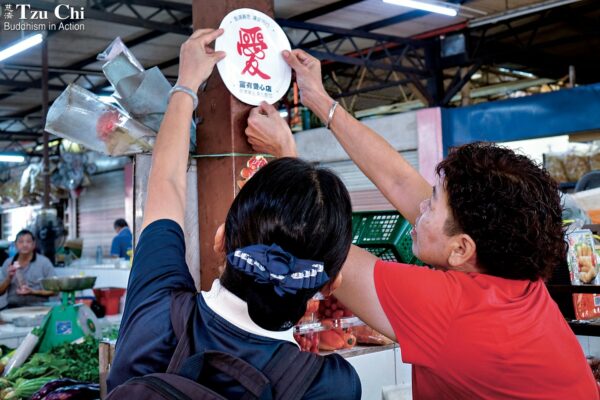By Yeh Tzu-hao
Translated by Wu Hsiao-ting
Photos by Yan Lin-zhao
With over 700 million people facing hunger worldwide, taking only what you can eat is a virtue. Elementary students at a Tzu Chi school in southern Taiwan are showing their values by taking action and doing their part

Empty food serving trays serve as evidence of the efforts made by this elementary class at Tainan Tzu Chi Senior High School to minimize food waste.

From the Farm to the Table, Food Doesn’t Come Easy
With the guidance of a gardening volunteer, students in the elementary division of Tainan Tzu Chi Senior High School sow water spinach seeds and carefully cover them with soil. Through firsthand farming experience, they learn to appreciate the effort required to cultivate food.
The Clean Plate Campaign
By Yeh Tzu-hao
Translated by Wu Hsiao-ting
Photos by Yan Lin-zhao
The leftover food from school lunches each day at Tainan Tzu Chi Senior High School’s elementary division has decreased from 35 kilograms three years ago to just three kilograms now. How did more than 600 elementary students achieve this?
Every school day, before lunch, students from the elementary school division of Tainan Tzu Chi Senior High School in southern Taiwan sing the “Gratitude Song”: “Each grain of rice, spoonful of soup, and piece of vegetable on our plates comes with great effort. Let’s savor each bite mindfully and be grateful to all those involved in making our food possible.” This practice helps instill the values of cherishing food in students, and aligns perfectly with the goals of the Clean Plate campaign.
Yen Hsiu-wen (顏秀雯), the director of academic affairs in the elementary school division, explained that the Clean Plate campaign was initiated in 2021 to tackle food waste. It was sparked by a visit to the school’s central kitchen, where students learned about the significant amount of waste generated by over 600 elementary students during lunch.
How much waste was there? The detailed records Yen Hsiu-wen kept show that the elementary division produced an average of 35 kilograms (77 pounds) of food waste each day. This amount is not large compared to the waste produced by similar-sized schools, but it added up to 3,500 kilograms, or 3.5 metric tons (3.86 short tons), of waste over a 100-school-day semester.
Yen was shocked by these figures. “Aside from the carbon footprint from food production and transportation,” she stated, “producing food costs money and requires farmers’ hard work. Moreover, with so many people facing hunger in the world, wasting this much food is simply unacceptable. That’s when we began urging everyone to finish their meals.”

Elementary students holding trays and bowls line up to receive their food.
Clean plate
Food waste is a widespread problem in the world, particularly in more affluent regions. According to Taiwan’s Ministry of Environment, each person in Taiwan has discarded an average of 24 kilograms (53 pounds) of food waste annually over the past decade. When factoring in losses from production and distribution, along with unsold food that is discarded, the total amount of food wasted in Taiwan each year exceeds one million metric tons (1.102 million short tons).
Three years ago, Yen Hsiu-wen guided students from the elementary division of Tainan Tzu Chi Senior High School to participate in the U.S.-Taiwan Eco-Campus Partnership Program, launched by the Ministry of Environment and the U.S. Environmental Protection Agency. This program aims to inspire students to address various environmental challenges, including the promotion of sustainable food practices. Participating in the program prompted students to visit the school’s kitchen. “We went to our school’s central kitchen to interview the nutritionist about lunch menu planning and to observe how they handled food waste,” Yen recalled. “It was only then that we realized how much food waste the students were creating.”
In response, students in the program’s food sustainability group researched online for relevant information, brainstormed ideas, and initiated the Clean Plate campaign. They advocated within the elementary school division to reduce food waste, encouraging both teachers and students to minimize the amount of food they discarded. They even created Clean Plate Ambassador certificates to commend classes that effectively cut down waste.
To monitor food waste, school lunch leftovers produced by each class were weighed each day. Wei Jing-xuan (魏靖軒), now a second-year student in the junior high division, was among the pioneers of the Clean Plate campaign during his elementary school years. He emphasized the importance of teacher guidance due to elementary students’ unfamiliarity with weighing and recording.
In addition to the involvement of students and teachers, the meal supply team at the central kitchen provided significant support. They assisted each class in weighing their leftovers and adjusted food quantities based on daily class sizes. These adjustments were particularly noticeable during the COVID-19 pandemic when fewer students ate at school. Students also encouraged each other to finish their meals, often sharing and consuming any leftovers together to minimize waste. They viewed it as an honor to earn the Clean Plate Ambassador recognition.
Nutritionist Ye Jia-wen (葉佳紋), who joined Tainan Tzu Chi Senior High School when it was established in 2007, also contributed to the effort. She shared her tips for planning menus, such as avoiding bitter melon as a main dish and relegating green bell peppers to side dishes. Additionally, she occasionally combined popular and unpopular items in the same dish to encourage the consumption of the entire meal. Her ultimate objective was to create dishes that kids would enjoy without sacrificing nutrition.

Food waste in the elementary division of Tainan Tzu Chi Senior High School has been significantly reduced by carefully planning meals and adjusting food quantities according to daily student attendance.
Tracking the numbers
Thanks to the concerted efforts of teachers, students, and the meal supply team, the endeavor to reduce food waste gradually yielded positive results. The Clean Plate campaign kicked off in September 2021; by the end of that first semester, in December, the total amount of food waste had decreased to just over 900 kilograms (1,985 pounds). This translated to only nine kilograms of food waste per day, marking a significant improvement from the previous daily amount of 35 kilograms.
Even more improvement was seen in the second semester of that school year, during which only 300 kilograms (660 pounds) of food waste was produced, averaging just three kilograms per day. To put that into perspective, among the 25 classes in the elementary division, each class produced only about 120 grams (0.26 pounds) of food waste per day.
But despite this success, the journey had its challenges. At one point, just as the total daily food waste had significantly dropped to 20 kilograms, it unexpectedly spiked back to 35 kilograms after a single meal. This sudden increase prompted an investigation into the cause.
It turned out that the main dish that day was udon noodles, a type of food that requires more chewing and is bulkier and heavier. The classes with the highest amounts of leftover food were the first and second grades. Children in that age group are losing their baby teeth, which weakens their biting and chewing abilities. Consequently, they tend to eat slower and consume less when faced with tougher food. This explained the increased food waste that day. Learning from this udon noodle incident, the central kitchen team began considering factors such as food texture and difficulty of chewing when planning menus to avoid similar situations.
Principal Yao Zhi-hua (姚智化) of the elementary school division particularly commended the meal supply team. He stated that they are not only skilled in vegetarian cooking but also work to ensure that students from kindergarten to high school receive the nutrition they need. In addition to providing daily lunches, they also serve dinner for junior and senior high school students during evening self-study sessions. Despite their demanding workload, the team wholeheartedly supports the Clean Plate campaign. “They operate with great care,” the principal noted. “It’s rare to hear any complaints from students or parents about the taste or portion size of the school meals. Their dedication is truly praiseworthy.”

The Clean Plate campaign aims to encourage students to cherish food.

Further efforts
The students who pioneered the Clean Plate campaign have already graduated from the elementary school division. Six of them have moved on to the junior high division of the same school, where they continue their efforts to reduce food waste under the guidance of social studies teachers Lin Yu-ru (林昱汝) and Chen Bo-ling (陳柏伶).
“[In the junior high division], we promote food waste reduction under a different banner: Design For Change,” explained Lin Yu-ru. Design For Change (DFC) is a global movement that fosters the “I Can” mindset in children. Lin elaborated that, unlike the teacher-directed approach of the Clean Plate campaign in the elementary school division, DFC empowers students to discover problems and develop strategies independently.
Junior high students are at a developmental stage where they begin forming their own opinions and perspectives. To capture the attention of these students, the food waste reduction team employs more captivating approaches. For instance, noticing that many students dislike celery, the team filmed a short video titled “Celery: To Love or Not to Love?” This video was shown during a morning school assembly.
In the video, eighth-grader Fang Zheng-hao (方正豪) takes a bite of celery and playfully questions his peers about their reluctance to eat the vegetable. Unexpectedly, everyone pushes their celery towards him, teasingly telling him to feel free to eat it all. This humorous scene kicks off the promotional video. Then, the team interviews teachers, schoolmates, and Tzu Chi volunteers about their attitudes toward celery before introducing its structure and nutritional value. Many teachers and students didn’t realize that the edible part of celery, often mistaken for a stem, is actually a petiole, a part of the leaf, until they watched the video.
Interestingly, Fang Zheng-hao himself does not like celery. “I had quite a few takes filming the segment where I ate celery. I think I ate enough celery to last me a lifetime,” he said. Despite his appearance in the video, his dislike for celery remains unchanged. Nevertheless, he recognizes the importance of not wasting food. He said, “Every food has its nutritional value, and we should be willing to try all kinds of food.” Zheng-hao’s twin brother, Zheng-yi (正毅), chimed in: “Regardless of whether the promotional video is effective or not, at least we made an effort to combat food waste.”
Zheng Qi-yun (鄭綺紜), the only female member of the team, noted that food waste is higher in most junior high and high school classes compared to the elementary school division. She attributed this to the busier academic schedules in secondary school, which distract students from the issue of food waste. However, she believes that with determination, it is still possible to reduce food waste or even achieve zero waste. “For example, after our class saw the video in the morning assembly, we asked our homeroom teacher to talk to the kitchen personnel about adjusting the amount of food provided to us,” said Zheng. “The amount of rice has since been reduced by one-third, for instance. After the adjustment, there has hardly been any leftover food in our class each day.”

After lunch, a student from the fifth-grade Gratitude Class returns their food serving trays for weighing leftover food and recycling. This class has successfully met the target for reducing food waste, earning them the Clean Plate Ambassador award displayed next to the classroom door.

Weighing leftovers is a daily routine after lunch. While some classes have reduced their leftovers to just a few grams, many have made zero leftovers the norm.
Responsible consumption
By launching the Clean Plate campaign and using actual measurements of food waste to raise awareness among teachers and students about the severity of the issue, the elementary school division of Tainan Tzu Chi Senior High School has successfully prevented over-serving and fostered food conservation.
This initiative is a positive response to global food challenges. According to statistics from the Food and Agriculture Organization of the United Nations, the production of major crops such as sugarcane, corn, wheat, and rice increased by 50 percent from 2000 to 2020. Despite technological advancements driving production beyond dietary needs, millions worldwide still suffer from hunger and malnutrition.
The waste from discarding food extends beyond just the food itself; it also encompasses the resources expended during its production, transportation, and storage. The Clean Plate campaign echoes the spirit of a carbon inventory. Cutting down on leftovers optimizes food use and lowers greenhouse gas emissions. Thus, the campaign is aligned with the United Nations’ Sustainable Development Goal 12, which calls for responsible consumption and production.
In the Clean Plate campaign, students gain knowledge, enhance communication skills, and bolster confidence. Moreover, all students responding positively to food conservation and leftover reduction benefit from balanced nutrition intake, fostering healthier growth.



